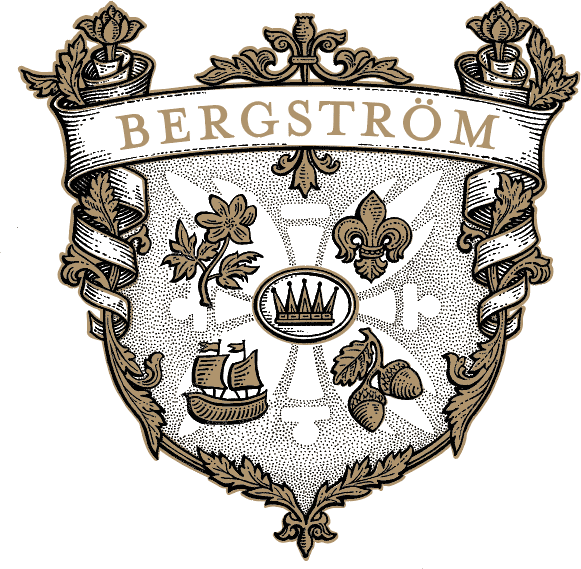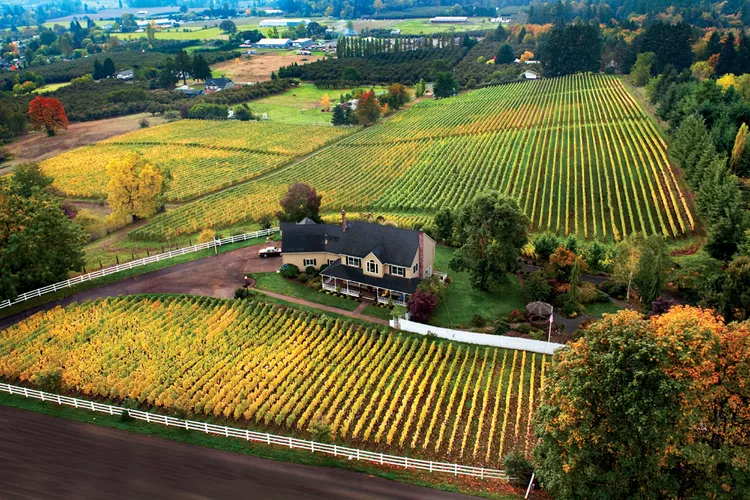Can the Willamette Valley Combine the Best of Napa and Burgundy to Become the Ultimate Wine Country Destination?
With new dollars comes the time to make critical decisions over the future of Oregon wine country.
:max_bytes(150000):strip_icc():format(webp)/Is-Willamette-at-Risk-of-Napa-Fication-FT-BLOG0923-330d66b864ff4aab9a136554624a8c62.jpg)
By the time Katie Jackson and Shaun Kajiwara opened the doors to Tributary, the married couple’s ultra-luxe boutique hotel in the quiet town of McMinnville in the heart of Oregon’s Willamette Valley, properties like Meadowood and Auberge du Soleil were celebrating almost 60 and 40 years (respectively) of high-end hospitality in Napa Valley. “To us, McMinnville feels very similar to the Healdsburg of 20 to 25 years ago,” explained Jackson, who runs sustainability operations for Jackson Family Wines, the ninth-largest wine company in the United States, in an interview with Food & Wine.
Kajiwara and Jackson have made perhaps the heftiest bet in modern history on McMinnville’s future as the central hub for visitors to Oregon wine country. With rooms that hover at around $1,000 a night (the highest per-night rate in the Willamette Valley by far), as well as an ambitious, farm-to-table flagship restaurant, Okta, where the chef’s tasting menu and wine pairing runs a cool $485, it’s easy to see how the property might catalyze the same onslaught of luxury investment, a trend which industry insiders like Bloomberg columnist Elin McCoy, call ‘Napafication.’ In a story published earlier this year, McCoy noted that many locals credit SingleThread with having sparked that same phenomenon in Healdsburg, an otherwise small town in Sonoma county.
Like Tributary, SingleThread is connected to a similarly intimate inn with just five luxurious guest rooms; SingleThread’s tasting menu and wine pairing experience, which earned three Michelin stars in 2019, is at roughly the same price point as Okta’s, which was just named one of the New York Times’ 50 best restaurants of 2023. It’s easy to see how Okta is poised to (at last) attract the Michelin Guide — and the dollars of investment that comes with it — to the state of Oregon. “We love SingleThread and are big admirers,” said Kajiwara. “There’s a lot of similarities in what we’re trying to do with our hospitality of offering a meal and accommodation in the same building, and in trying to grow a lot of our own produce on the farm. We’re trying to get to the three Michelin star level.”
:max_bytes(150000):strip_icc():format(webp)/Is-Willamette-at-Risk-of-Napa-Fication-FT-2-BLOG0923-fc355d340e44424792887480751b94e3.jpg)
The many parallels make it an increasingly important time to ask the question that many winemakers, bloggers, and even TIME magazine have been hemming and hawing over in recent years: Are we all simply watching the slow but steady so-called “Napafication” of Willamette Valley? And if so, is that necessarily a bad thing? Could this be an opportunity for Willamette to remake Napa in a way that does right by winemakers, tourists, and hospitality professionals alike?
Pinot paves the way
As Oregon Pinot Noir continues to rise in prominence (a recent report shows that in 2022, regional volume increased by 3% to 5.3 million cases) it’s unsurprising that vineyards in the region have attracted attention from major players in Napa and Sonoma. Constellation Brands staged a well-covered acquisition of Eoly-Amity winery Lingua Franca just last year, following in the footsteps of Napa’s Silver Oak, which in 2017 purchased the Prince Hill Vineyard from Dick Erath, one of the Willamette Valley’s original winemakers. Jackson Family Wines has acquired four Willamette Valley vineyards over the past decade. Burgundian wineries, no doubt enticed by Willamette’s similar climate and demonstrated ability to produce world-class Pinot Noir, have long been planting roots in Oregon as well, notably Domaine Drouhin in 1989, and Maison Louis Jadot, which acquired Résonance vineyard in 2013.
“Distributors were shy about Oregon wine in the ’70s and ’80s,” said Josh Bergström, general manager and winemaker of Bergström Wines, which has been producing Pinot Noir, Chardonnay, and Syrah in the valley since 1999. “If your goal is to make one million cases a year and you just know it’s going to start raining, that’s risky.” 2014 through 2017 were the hottest vintages in Oregon’s history, and this year was hot and dry [perfect weather for wine grapes] as well. “It’s hard to remember the last bad vintage in Oregon. People are much more excited about investing here because there’s a much clearer return now,” he added.
:max_bytes(150000):strip_icc():format(webp)/Is-Willamette-at-Risk-of-Napa-Fication-FT-4-BLOG0923-b7a4a3fc44744136a1f0029706aafd74.jpg)
Although it’s easy to see how investment from major players outside the region and the subsequent rise in the profile of Oregon wines could turn into a recipe for unchecked development, the region has several key ways to chart a different course than Napa and Sonoma. “We’ve had people try to build Auberge du Soleil or other spas and inns here,” he said. “They can’t, because the pioneering families [of Oregon wine] recognized the tremendous value of this land back in the ’70s, and passed laws to preserve land use for agricultural purposes.”
San Francisco and Portland — the two closest cities to Napa and Willamette, respectively, are also quite different in socioeconomic makeup and urban density. While getting from San Francisco to Napa can take almost two hours due to the area’s infamous traffic and congestion troubles, the drive from Portland to Willamette generally doesn’t take more than 45 minutes or so. “We’d love to see more tourists come in from Portland, and help that city rebuild after COVID,” Bergström said, noting that he’d support a light rail system to make the connection between Portland and Oregon wine country even stronger.
The promise of a downtown-driven wine country
Having temporarily left McMinnville in 1991, a time when many storefronts would stay empty for months on end, Jason Lett, the second generation winemaker behind Oregon’s pioneering Eyrie Vineyards, returned in the late ’90s to see an inspiring uptick in investment downtown. “The Hotel Oregon was, at the time, getting a big renovation,” he explained in an interview with Food & Wine. Lett credits the restoration of that property — a historic building from 1905 in need of some serious attention — as a key, early example of thoughtful hospitality investment in Yamhill County, which includes the towns of McMinnville, Carlton, Dundee, and Newburg.
“I’m personally really gratified by some of these investments in our downtowns,” said Lett, who is a critic of what he (and many other local winemakers, as well as members of preservationist organizations like Friends of Yamhill) considers to be a rising tide of commercial development on farmland. “If you look at Burgundy or Piedmont, you won’t see huge tourist infrastructure built on vineyards because they are simply too precious,” Lett explained. “Our vineyards will lose their value if people can just turn them into touristic destinations that sit apart from the farming use.”
While that potential to encroach on farmland (as opposed to staying outside agriculturally zoned limits, and closer to downtowns) is naturally higher for larger resorts than it is for small bed and breakfasts and inns, some developers — like Ken and Joan Austin, who opened the Allison Inn & Spa in the early ’00s — have made it clear that size isn’t an excuse. “Before the Allison Inn & Spa opened, there was a proposal for a big golf resort at the top of the Dundee Hills,” Lett recalled. “The people who were trying to develop that property were saying there was just no way to offer a ‘premium experience’ inside the small towns of Yamhill county. They would go off and talk about how those towns were charmless.”
The Allison has 85 rooms, an indoor swimming pool, spa treatment rooms, and various other bells and whistles that echo that of Napa and Sonoma’s tony resort scene. Since opening in 2009, the resort has proven what Lett considers thoughtful investment in the parts of wine country that should be used to expand the region’s tourism infrastructure. “We need to take our farmland seriously,” he added. “I’m agnostic about where the source of money comes from, but I’m wildly enthusiastic when that money is invested in our local towns. We have so much cool stuff to offer here.”
It’s a fine line between “Wine Disneyland” and a rising tide
Many winemakers in the valley are heartened by restorationist efforts like those from Jackson and Kajiwara, who capitalized on the potential of a century-old former hardware store in downtown McMinnville. The property took several years of renovation to convert into Oregon’s first Relais & Chateaux hotel, and in 2020, the town rewarded the couple with an award for best historic preservation. The couple knows that this kind of acceptance doesn’t come easily. “There have been a lot of other [hotel] project proposals that just haven’t been approved by the town,” Kajiwara said.
Bergström shared that the vast majority of his business is done through his family’s tasting room in the Dundee Hills, in a stunning space that was once the family’s private residence. With direct-to-consumer and on-premise sales from visits becoming an increasingly popular way for wineries to make money, tourist infrastructure isn’t just welcome, it’s critical.
:max_bytes(150000):strip_icc():format(webp)/Is-Willamette-at-Risk-of-Napa-Fication-FT-3-BLOG0923-4aa4df0130774ed08d47447328c30026.jpg)
What we’re watching now is whether or not Willamette can pull off what has historically proven to be a complicated balance between American wine country that defends the primacy of agriculture and the value of farmland, and practices paving the way for tourism that buoys both winemakers and other local businesses. “The big risk is when bigger players who don’t care about history and community show up, and they just wanna make money,” said Bergström. “That’s when you see that ‘rising tides that lift all ships’ start to erode at 60 years of community.
His proposed solution? “I say let’s develop the Willamette Valley on our own terms…with people who are responsible and respectful of our region investing here.”

